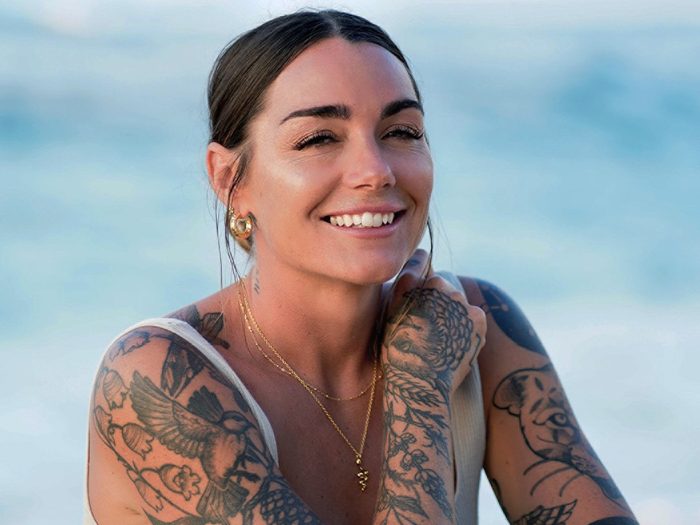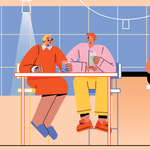How I Coped After My Husband Was Diagnosed With the Same Cancer My Father Died Of

In this excerpt from her memoir, Everything All At Once, Montreal-born Steph Catudal explores the pain she felt when her husband, Rivs, was suddenly hospitalized at the height of the pandemic.
The evening Rivs was wheeled into the ER, I felt a hollowness—a separation far more isolating than physical distance. For the first time in our twelve years of marriage, the space between us felt uncompromising.
Weren’t you just right here?
Rivs and I were twenty-two when we met. Our life together was built on the painstaking labor of young love, evolving expectations, and a cycle of collaborative new beginnings. I always looked to him for strength, especially in times of hardship. I believed that I needed him, that my own power came through him and our union because of what I had been taught, that it was only through god and with a man that I would be complete. That by myself I would never become what I was created to be.
Perfect and whole.
Who was I without him? What was home if not us?
I turned from the hospital and walked back to the car, the night a haunting bleakness despite a brilliant display of stars. Strange, how pain can obscure what’s in front of us, like a lens we don’t even know we’re looking through. In its distortion, everything feels incurably dark.
Over the years, between Rivs’s long training hours, my writing ambitions, and our respective grad school endeavors, we had grown accustomed to being apart. Soon after Iris was born, Rivs was hired by a production company, which required him to go overseas several times a year, sometimes in two-week stretches. At first these jobs were sporadic opportunities, but they soon became our primary source of income—much more lucrative than sponsorships, race winnings, or work as a physical therapist. Eventually the payouts from his work trips allowed me to step away from serving tables and focus more on my writing career. I was also able to stay home with our kids in their baby and toddler years, which, it turns out, was what I wanted to do more than anything else.
When Rivs and I were apart, I started to consider the ways I relied on him in situations I could handle on my own. I regained some of the independence I had lost between young marriage and raising children. I grew comfortable being alone and Rivs encouraged my independence. He urged me to travel and write between his work trips, to reestablish the sense of self I had relinquished in early motherhood. Although we struggled to get it right and we were a far-from- perfect couple, in many ways distance allowed our marriage to maintain the autonomy and longing that is sometimes lost in more traditional partnerships.
But as I drove home from the hospital that evening, I felt the harsh difference between loneliness and being alone. Despite our worn-in physical separation, I always had the default of knowing that Rivs was just a phone call away.
Now, I felt the loneliness of his absence. He was just across town, but there were oceans between us. I had been here before and knew what it meant: there would be no assurances extended across the void, no softly mouthed words telling me to “take it easy.”
There was no more deferring to his strength.
What I hadn’t yet realized is that throughout the course of our marriage, I had been expecting him to validate my broken pieces—to fix what had been fractured by my father’s death. This unspoken expectation was an untenable demand, and one I didn’t even know I had made. It all came out as projections of deficiency on his part. Over and over I blamed him for my pain when his love couldn’t save me.
When he failed to make me whole.
Rivs’s hospitalization forced me to recognize a truth I had been avoiding: I didn’t know how to be alone.
When he called from the ICU several hours later, he spoke to me in looping metaphor—confused as to where he was and why. High-flow oxygen had lifted him out of hypoxia, but he was now on a slew of painkillers and sedatives, which further distorted his reality and demeanor.
In a meandering conversation sustained by the static of forced air, I gathered that a chest X-ray had found “innumerable” nodules in his lungs. The doctors were unsure what had caused these lesions, which made a medical plan of action difficult, if not impossible. Assuming he had COVID-19, the medical team would need to wait for a positive test result before treating him. In the meantime, they administered the same antibiotic and corticosteroid combination Rivs had given himself at home—only intravenously and in higher doses. Without a diagnosis, all they could do was nurse his symptoms and treat him for a general lung injury.
When I told our girls that their dad was in the hospital, they responded with love and apathy. Our children were accustomed to having a resilient father in extreme circumstances from which he always returned.
My heart broke with their familiar response. I knew the feeling well.
***
The first week of his hospitalization was a blur of unanswered questions. Rivs was on a cocktail of heavy narcotics and couldn’t fully understand what was happening—a disturbing occurrence for someone so attuned to his body. He spent most of the day asleep and would often doze off or lose consciousness mid-sentence whenever we talked on the phone. Other than a CT scan showing thousands of unexplained pulmonary masses and a decimated blood platelet count, no one knew what was wrong with him. Even after three negative in-hospital COVID-19 tests, the leading medical theory was that he’d been infected by an undecipherable strain of coronavirus—the same theory Rivs had believed all along.
“Undiagnosed pneumatological infection or injury. COVID-19 negative. Stable and oriented on four liters of high-flow oxygen,” the nurse read from a computer screen each time I called for a synopsis of his condition.
“But this is my husband,” I wanted to shout. “He’s not just another statistic.”
I had watched the COVID-19 body count tick upward on the news, but I was only now coming to understand the depths of its tragedy—a personalization of the individual pain that constitutes a global pandemic. For the first time, I felt a humanization of the worldwide trauma before me.
I could no longer complain about fickle quarantine rules or stressful school closures once I felt the heartbreaking reality of having a loved one suffering alone in the ICU.
Sometimes the universality of pain is recognized only after we experience it for ourselves. Knowing I’d only scratched the surface, I wondered how far I’d been alienated from the depths of human suffering, how heavily I had been blinded by my own privileged perceptions.
Perhaps this was the purpose of a broken heart, to be fractured enough to feel it all. Maybe pain was myopic only when I failed to acknowledge all the love waiting to shelter it.
***
During that first week, time crawled forward while my heart was both broken and opened at once. I had never experienced such pain, and at the same time, I had never felt so much love for the world. I had been stripped bare; my armored layers peeled back to the fragility of human existence.
And I lived there, in the thick of universal agony with a deep love for it all, until eight days after his admission. That morning, there was a gutting variation to the nurse’s daily update.
“Undiagnosed pneumatological infection or injury. COVID-19 negative. Stable and oriented on max high-flow oxygen . . . Acute right pneumothorax.”
The day before, a surgeon had performed a fine-needle lung biopsy to determine the origins of Rivs’s lesions. In my recent research on lung disease, I learned that pneumothorax, or a collapsed lung, was a potential side effect of a pulmonary biopsy. I had prepared myself for this possibility prior to the procedure, but because it was Rivs, I assumed he’d avoid any complications.
Trying to compose myself—because that’s how I thought the wife of a critically-ill partner should be, composed—I asked the nurse if I could speak to Rivs directly. Most days I waited for him to call me first, partly to avoid the risk of waking him, but mainly because I was terrified of the endless ringing that often went unanswered.
This time, I heard the harsh roar of oxygen as he fumbled to pick up the phone. His voice was a rush of fabricated breath.
“It’s bad, babe. I’ve got this tube sticking out my chest. I feel like I’m being waterboarded. I can’t take a deep breath. They put this mask on me but there’s still not enough air in my lungs. I can’t get enough oxygen. I can’t breathe. Steph. I don’t think I’m going to make it.”
Click. Silence. Loneliness.
Oxygen. Lungs. Breath.
These words held memories cloaked in a sadness so thick I could barely see straight. Even more frightening was the fact that I had never heard Rivs panic before. Ever.
With a collapsed lung and a tube in his pleural cavity to drain fluid from his chest, the severity of Rivs’s illness was finally sinking in.
That night I cried while putting six-year-old Iris to bed, the second verse of her favorite lullaby breaking the composure I was trying to maintain.
The other night dear
as I lay sleeping
I dreamt I held you in my arms

From the book Everything All At Once by Steph Catudal Copyright 2023 by Stephanie Catudal. Reprinted by permission of HarperCollins Publishers.




